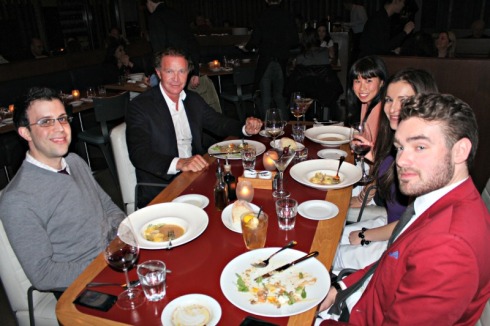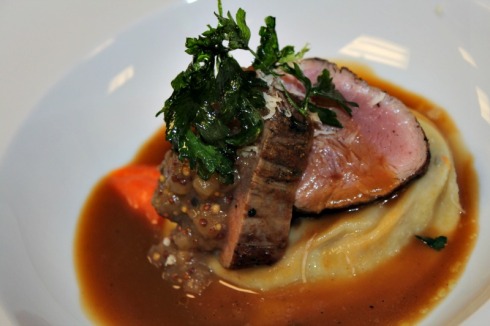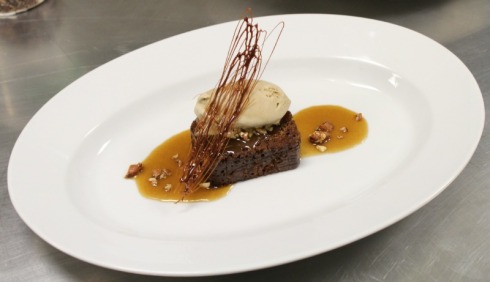
Those who have been following this blog may remember our tiramisu saga that began a few months ago. And for those of you who are new here, you can read the first two installments of mine and Neil’s crazy quest to find the perfect tiramisu recipe here and here.
This may just be the end though, because the recipe I’m posting below came pretty close to tiramisu nirvana.
After my last try at homemade tiramisu, I knew I wanted to make it again but didn’t think I’d take on the challenge for a while. It’s not that making this classic Italian dessert is hard, it’s just time consuming and I wanted to make sure the next attempt would get it right.
But after reading about our earlier trials and tribulations, my sister Jayme requested that I make it for her birthday this year. And that’s what started my little tiramisu science lab, if you will.
This time, I decided I was going to develop my own recipe. I wanted to use Madeira wine once again and I knew we were after a saturated consistency in the cookie layer and a smooth, creamy texture in the cheese layer.
After my last try, Toronto food expert Christine Picheca chimed in with some advice and told me to ditch the ladyfinger cookies and try savoiardi biscuits instead. Because they’re more porous, she said they would give me the consistency I was looking for. Last time the ladyfingers I used made for a very cakey and dryer tiramisu than I wanted.
I researched a lot of different recipes this time around, some using anywhere from 3-6 eggs, some using anywhere from 3 tbsp to a whole cup of sugar and some using more or less mascarpone.
Most recipes claiming to be ‘authentic’ (including the one on the savoiardi biscuits package) only called for egg yolks and no whites. None of them called for whipping cream, which I thought seemed wrong the last time I made it but I didn’t want to stray from the recipe I chose to follow at the time.
To make sure I was using the best possible ingredients, I made a special trip to Fiesta Farms, one of our favorite places to shop for quality food in Toronto. Their selection of ethnic food items, especially Italian products, is amazing and I even found mascarpone cheese imported from Italy.
I actually planned on only using the egg yolks, but I found the consistency of the mascarpone to be too dense. So I whipped up two of the whites, mixed them in and the consistency seemed just right for our taste.
People have lots of opinions about what kind of espresso to use and how to brew it (espresso machine, Italian stovetop espresso pot etc..) but I think that most good-quality strong espresso will do and you should brew it any way that makes sense for you at home. Once again I made mine in a French press using really good quality Italian espresso and I really think that’s fine. We do have a stovetop espresso maker but I just didn’t feel like using it. The result I got was perfect. I do of course agree that you should always use espresso and never regular coffee grinds, but how you make it is up to you.

And so, after lots of geeky research, discussions and testing, the recipe that follows is completely original to Communal Table and, if I do say so myself, pretty freaking awesome.
Everyone at my sister’s birthday celebration raved about it. My brother-in-law told me that he doesn’t normally like tiramisu or any dessert with alcohol in it (we’re clearly not blood-related) but even he really liked it! How’s that for a stamp of approval?
The savoiardi biscuits really made a huge difference. They made for a lighter, fluffier cookie layer and did take in the liquid much better than denser ladyfingers. The whole dessert was light while still being nice and rich, intense in flavor and totally satisfying. Everyone wanted more, and that’s how I know we’ve come as close as can be to perfection.
Communal Table’s Tiramisu

Serves approx 10-12, using a large rectangular pyrex dish
4 egg yolks
2 egg whites
3 Tbsp sugar
2 x 250 g containers of mascarpone cheese (you will use 1 whole container plus ¾ of the other. One container = approx 1 cup)
1 generous cup strong espresso
1 cup Madeira wine (or a strong alcohol of your choice like brandy or rum)
48 savoiardi biscuits
Cocoa powder
Brew your espresso and let it cool.
In a large mixing bowl, using an electric mixer, beat the egg yolks with the sugar for a few minutes until you get a smooth consistency and all of the sugar granules are incorporated and disappear.
Add the mascarpone into the egg mixture and beat on a medium setting to get a smooth, creamy texture.
Clean the beaters and get a fresh bowl. Beat the egg whites for a couple of minutes until they’re nice and fluffy. Don’t over-mix. You don’t want them to form heavy peaks (like you do for meringue).
Fold the egg whites into the mascarpone mixture. Once again, don’t over-mix.
Pour the cooled espresso into a shallow, flat-bottomed bowl or pan and add in the Madeira.
Place your pyrex dish (or tiramisu receptacle) right next to the espresso bowl and get your biscuits ready.
Lightly dip each biscuit in the espresso mixture, sugar-side up, then transfer to the pyrex dish and place sugar-side down. I cannot stress enough how light of a dip the savoiardi biscuits need. They are very porous and will get really soggy fast if you let them sit in the liquid.
We like our tiramisu to be very wet so I dunked the entire biscuit into the liquid and swished it around for a second. If you like a more cakey consistency, make sure you really dip lightly on one side only or use thicker ladyfinger cookies.
Line the entire pyrex with the dipped biscuits. Cover the layer of biscuits with a layer of mascarpone mixture. Don’t use too much, you just want enough to cover the entire layer, but don’t put it on too thick.
Continue with the rest of the savoiardi biscuits, placing them on top of the mascarpone mixture to create another layer. Top that layer with the rest of the mascarpone mixture and spread evenly.
Cover the tiramisu with plastic wrap and refrigerate (make sure you’ve cleared a good space for it in your fridge beforehand!) for at least 6 hours or overnight.
Just before serving, sprinkle the tiramisu with a dusting of cocoa powder.

Special thanks to my tiramisu-convert bro-in-law Stewart for the photos
Tags: dessert, Italian, madeira wine, mascarpone, sweet, tiramisu


































































